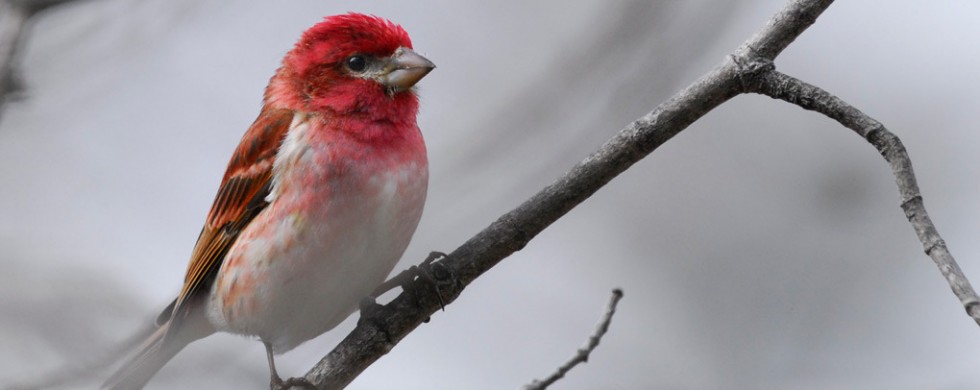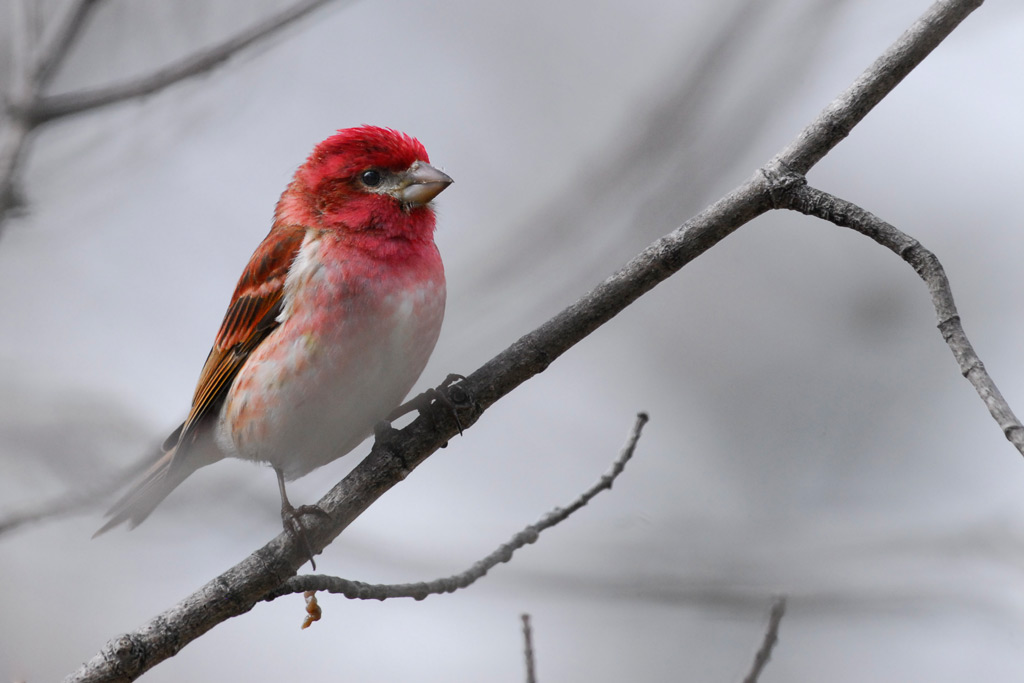
28
2012Purple Finch
Shot of the Month – December 2012
 This month an image that hints at the beauty of the male Purple Finch. Do not adjust your monitor — the name is a red herring. There is nary a purple feather to be found on the fellow.
This month an image that hints at the beauty of the male Purple Finch. Do not adjust your monitor — the name is a red herring. There is nary a purple feather to be found on the fellow.
A more accurate, and superbly sublime, description of this bird was offered by Robert Tory Peterson (all birders in the crowd are now bowing in reverence…)… when he said that the male Purple Finch looked like a “sparrow dipped in raspberry juice.”
What can I add to that mental image that won’t seem terribly pedestrian?
No raspberry dipping for the female — she is is striped strictly in brown and white giving a very monochromatic sparrow-like appearance.
Purple finches breed in Canada and live year-round in Northeastern US and along the American Pacific Coast. In the winter many will migrate down from Canada into most of the states in the eastern half of the US.
Purple Finch Fun Fact: They are the state bird of New Hampshire.
Many people confuse the Purple Finch with the House Finch — they look quite similar. A quick tip for telling them apart: The Purple Finch’s beak is conical shaped while the House Finch’s upper mandible is curved downward. Over the past 40 years, the range and number of House Finches has grown significantly across the United States while the number of Purple Finches has dropped dramatically. Seems that the House Finch is rather aggressive and typically wins the battle for food against the Purple Finch.
Purple Finches dine, at least when House Finches aren’t around, primarily on seeds, berries, and insects. At backyard bird feeders they are particularly fond of black oil sunflower seeds or millet.
Is it just me, or is this whole “purple’ thing driving you crazy, too? Why does a rose-colored bird have “purple” in its name??!! I did some digging. The best answer I can find came from Chris Petrak:
Aside from the fact that bird names often make no sense, why is it called “Purple Finch?” To answer that, we need to know its scientific name: Carpodacus purpureus. The genus name comes from Greek and means “fruit eaters,” a questionable name for birds which are seasonal fruit eaters, but year-round seed eaters. The species name, purpureus, comes from Latin and means “crimson” or other reddish color. Our word “purple,” meaning a color obtained from mixing red and blue, derives from the Latin, purpureus. The Purple Finch is really a crimson-colored finch. Or, translating its scientific name, it is “crimson fruit-eater.” When taxonomists give birds their scientific names and common names, they put aside their science and become impressionistic artists.
A few other writers put forth that the word “purple” in days of olde used to be understood to be much redder in hue than as understood in our modern take of said color. So, way back when, the use of “Purple” Finch would have been more accurate.
Neither answer is terribly satisfying, however I console myself by imagining raspberry sparrow dunking, and my spirits are immediately lifted.
Until next month…Happy New Year!

Iri
Dear Michael
I Thank you for being with us the all year.
I also take this opportunity to wish you a Marry Christmas and a Happy new year.
Hope you will be as energetic as you have been last year.
All the best and keep in touch.
Iri
Michael
Thanks Iri..all the best to you and the family!